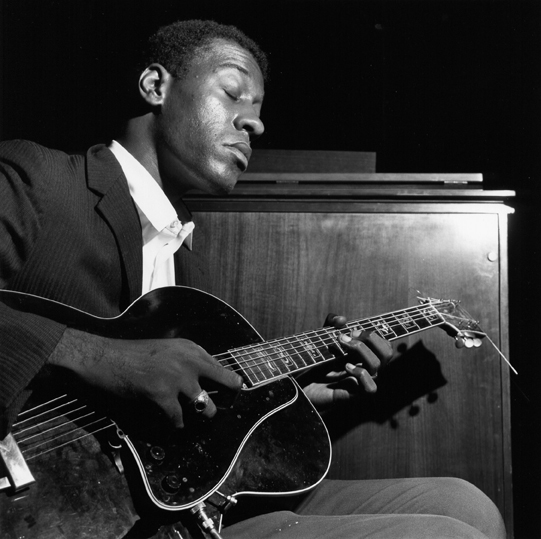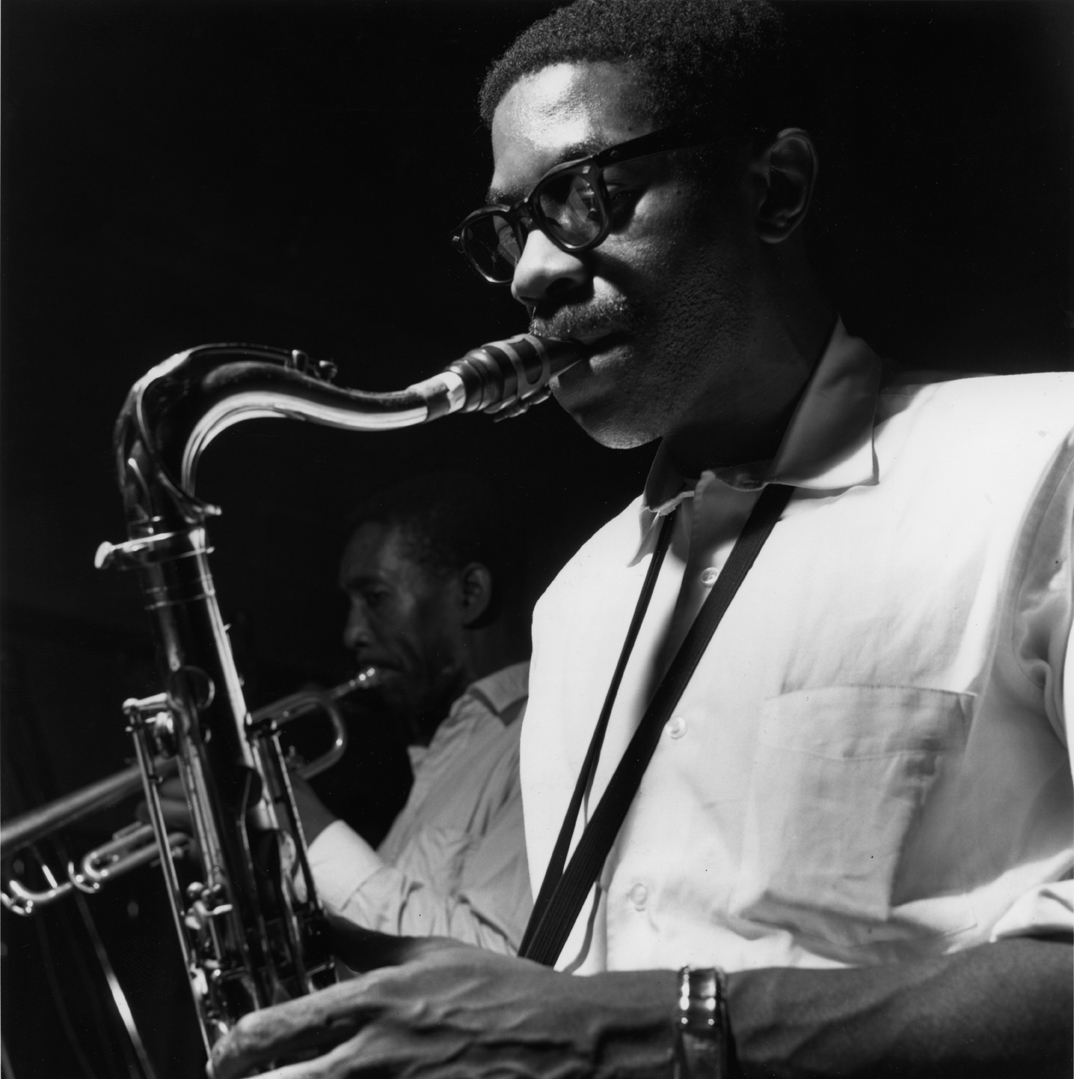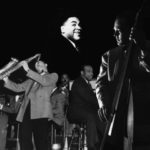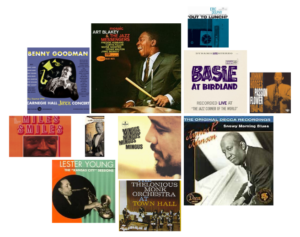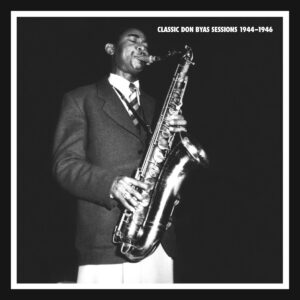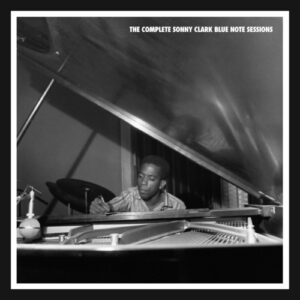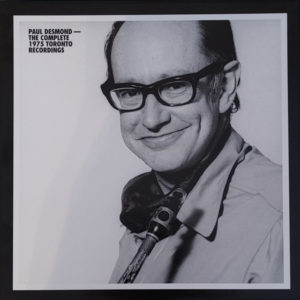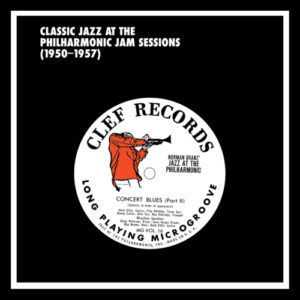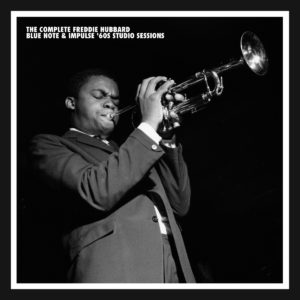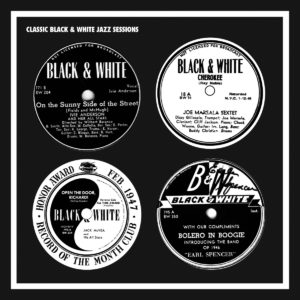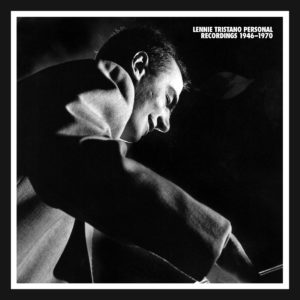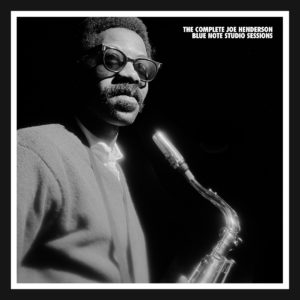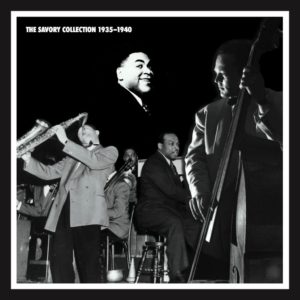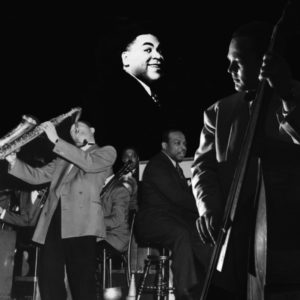Grant Green
Grant Green was a master of rhythm accent and displacement and this is a far more subtle virtuosity than encyclopedic harmonic knowledge or quicksilver arpeggio running. - Bob Blumenthal
Grant Green
Grant Green takes a note or a basic phrase and repeats it over several bars, which can sound limited if you miss how the shifting stresses reveal the several meanings the idea can take on. He is an expert at generating amazing swing within a melodic idea by leaning into some notes and back on others, creating an irresistible ebb-and-flow.
The growing appreciation for these nuances explains why Grant Green is held in higher esteem posthumously than in his lifetime.
Developing his own style
Grant Green was born in St. Louis Missouri on July 6, I931. By the age of 13, he was working professional jobs in his hometown and across the Mississippi River in East St. Louis, Illinois. He would remain a vital part of this scene until he relocated to New York in I960.
During these years he developed his distinctive style which for the most part avoided chordal playing and intervals in favor of single-note lines (so as not to crowd the pianist or organist, he explained to critic Robert Levin). To a large extent, this evolution can be traced to Grant Green’s musical preferences.
“I don’t listen to guitar players much. I dig horn players. I was very much influenced by Charlie Parker, very much. And among guitarists, there was Jimmy Raney. I like his style of improvising, and he gets a good sound…I also like Kenny Burrell very much…and, of course, there was Charlie Christian. I love his records. You can’t get around him.” – Grant Green
With his bluesy, riff-based approach, Grant Green’s debt to Christian was clear, and in many ways, he was the most Christian-like of the legendary guitarist’s followers. It was the horn players though, that provided an equally strong influence. Grant Green told Levin of the nights he would stay up transcribing Parker solos; and a look at his repertoire verifies that he was also hearing Miles Davis, Sonny Rollins and John Coltrane.
Two saxophonists turn out to be important mentors.
Tenor man Jimmy Forrest worked extensively with Grant Green in St. Louis during the’50s; at decades end, when Forrest was touring with the Harry “Sweets” Edison quintet and had the opportunity to record for Delmark with Edison’s rhythm section (Harold Mabern, Gene Ramey and Elvin Jones), he had Grant Green flown to Chicago for the dates. The resulting albums, All The Gin Is Gone and Black Forrest are the earliest documents of Grant Green’s skills.
Around this same time, alto saxophonist Lou Donaldson heard Grant Green during a tour of the MidWest. He encouraged the guitarist to move to New York, introduced him to Lion and Wolff, and brought him into Rudy Van Gelder’s studios for the first time on January 23, 1961 for the album Here ‘Tis. – Bob Blumenthal, liner note excerpt Mosaic Records: The Complete Blue Note Recordings of Grant Green with Sonny Clark
Grant Green & Partners
At the heart of so much great jazz there is something ineffable, having to do with how each musician relates to his or her partners. We can’t always articulate what occurs when solo line, chordal comp, bass walk and drum beat mesh, but we can surely hear and feel it. We hear and feel it in the Count Basie band, with the All-American Rhythm Section, and in the Miles Davis quintet on more than one occasion.
Some credit is due the discerning Blue Note trust of Alfred Lion and Francis Wolff, but Grant Green had a knack for striking up such complementary partnerships over the course of his career. – Bob Blumenthal
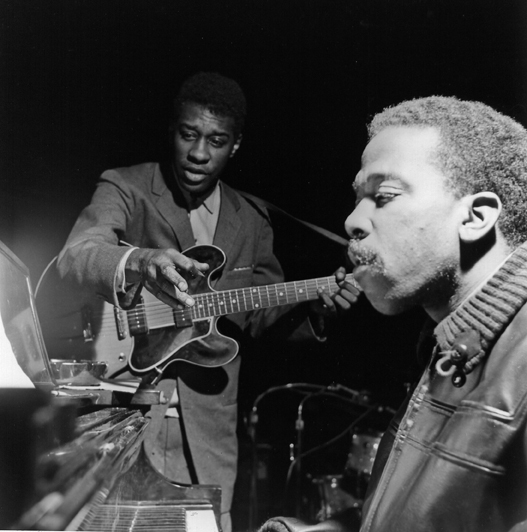
© Mosaic Images; photograph by Francis Wolff
Green Dolphin Street
December 23, 1961
Grant Green (g) Sonny Clark (p) Sam Jones(b), Louis Hayes(d)
“On Green Dolphin Street” begins very close to the classic l958 Miles Davis sextet version, with Sonny Clark’s unaccompanied intro recalling his friend Bill Evans and Sam Jones stroking pedal points on the theme a la Paul Chambers. The pianist retains his opening break figure going into the guitar solo, though and the performance quickly gains a more personal stamp. Grant Green, rising to the rhythm section’s hard-grooved challenge, creates two inspired choruses, while Clark inhabits that zone of his (especially in his first chorus) where phrases seem to fall off a log. Jones gets one, and shows his usual strength without strain, while Grant Green is more insistent in his return statement.
© Mosaic Images; photographs by Francis Wolff
Solid
Minor League
June 12, 1964
Grant Green (g) James Spaulding (as) Joe Henderson (ts) McCoy Tyner (p) Bob Cranshaw (b) Elvin Jones (d)
Grant Green was so busy in the Blue Note studios as the label’s house guitarist during 1961-65 that some of his sessions were not originally released until after his 1979 death. Still, it is surprising that Solid had to wait so long to be made available for it features the jazz artist with quite an all-star group, one that might have been a bit taken for granted at the time but is quite timeless.
During his prime years, Grant Green had an instantly recognizable style, one that emphasized single-note hornlike lines over chords. He was quite versatile, sounding equally comfortable with organ groups, in a quartet where he was the only “horn,” or with all-star groups, whether playing straight ahead jazz, hard bop, Latin, spirituals or even “Tumbling Tumbleweeds” and “I Want To Hold My Hand.”
Solid teams Grant Green with tenor-saxophonist Joe Henderson, altoist James Spaulding, pianist McCoy Tyner, bassist Bob Cranshaw, and drummer Elvin Jones. Listeners not familiar with this album and who think of Tyner and Jones during the era as being primarily John Coltrane’s sidemen will be a bit surprised at how easily and naturally they adapt themselves to this straight ahead music.
Joe Henderson has long been recognized as one of the all-time greats but James Spaulding is often overlooked. Check out his extensive solo on “Minor League,” a medium-tempo Duke Pearson blues. Spaulding set the standard for the entire album, making one wonder why, unlike Henderson, Tyner, Jones and of course Grant Green, he never had the opportunity to lead his own album for Blue Note.
After Spaulding lays down the gauntlet, the solos by Grant Green, Henderson and Tyner keep the momentum flowing on “Minor League.” George Russell’s “Ezz-thetic” (his take on “What Is This Thing Called Love”) is taken at a raging tempo. Grant Green manages to sound bluesy, Spaulding is passionate, and Henderson, Tyner and Jones all make memorable statements.
The guitarist’s “Grant’s Tune” is an inventive soul jazz piece that has the flavor of the Mid East while Sonny Rollins “Solid” gives the musicians an opportunity to dig into the boppish number. Joe Henderson’s “The Kicker,” with its memorable melody line, should be played more often. Both of the saxophonists excel on that piece.
Solid is one of Grant Green’s finest Blue Note albums even if it had to wait nearly two decades to be released.
Grant Green
Selected Jazz Albums
by Scott Yanow
One of the great jazz guitarists of the 1960s, Grant Green was a soulful bebopper during his prime years before taking a different turn at the end of the decade.
Grant Green was unusual in that he almost always played single-note lines. More of a horn player than a member of the rhythm section, Grant Green rarely played chords or was that active accompanying others. He was influenced by Charlie Parker and guitarist Charlie Christian, developed his own musical personality, and kept an ear open towards newer developments.
Altoist Lou Donaldson heard the guitarist and was impressed, used him on a tour, and influenced Grant Green to move to New York. Donaldson also urged Alfred Lion to sign him to Blue Note. It did not take long for Lion to be convinced that Grant Green would be perfect for the label, both as a leader and a sideman. During 1960-65, the guitarist was on more Blue Note albums than anyone else: 21 as a leader and 31 as a sideman, not counting unreleased dates.
He was a key part of recordings led by saxophonists Lou Donaldson, Stanley Turrentine, Hank Mobley (Workout), Booker Ervin, Ike Quebec (Blue And Sentimental), Don Wilkerson, Harold Vick, and George Braith, trumpeters Lee Morgan (Search For The New Land) and Donald Byrd, pianists Horace Parlan and Herbie Hancock (My Point Of View), organists Baby Face Willette, Jimmy Smith, Big John Patton, and Larry Young, vibraphonist Bobby Hutcherson (The Kicker), and singer Dodo Greene.
Grant Green was a most valuable jazz musician to have around. He worked equally well with pianists (his single note playing never conflicted with their chords) and organists, and was a flexible improviser who seemed to fit comfortably into every setting.
First Session (Blue Note)
Grant’s First Stand (Blue Note)
Grant Street (Blue Note)
Sunday Morning (Blue Note)
Unlike most Blue Note artists of the classic era, Grant Green first recorded for the label as a leader rather than a sideman. First Session, from Nov. 26, 1960, has him playing with three well-established greats (pianist Wynton Kelly, bassist Paul Chambers and Philly Joe Jones). The jammed music is enjoyable, but the set went unreleased until 2001. Perhaps Alfred Lion simply felt that Grant Green could play more challenging material than this set of blues and bop standards.
Lion probably had the music of Grant Green’s First Stand (from Jan. 28, 1961) more in mind. For this trio outing with organist Baby Face Willette and drummer Ben Dixon, Grant Green contributed three originals and Willette one; they also perform two standards. Throughout the program, Grant Green shows that he could play quite credibly and creatively with any organ group, a skill that would be often taken advantage of during the next few years.
Green Street from April 1, 1961 features the guitarist in a sparse pianoless trio a la Sonny Rollins with bassist Ben Tucker and drummer Dave Bailey, a logical setting for him (although one rarely utilized) since his solos were hornlike.
Sunday Morning (June 4, 1961) has Grant Green, Tucker and Dixon joined by pianist Kenny Drew. That certainly changes the sound of the ensemble from Green Street while giving the leader Drew as a strong soloist to play off of. The material, which includes such Grant Green originals as “Freedom March,” “Sunday Mornin’,” and “Come Sunrise” along with explorations of “Exodus” and “So What,” challenges the musicians and makes this one of Grant Green’s strongest sessions as a leader up to this point.
The Complete Blue Note Recordings Of Grant Green With Sonny Clark (Mosaic)
The Complete Quartets with Sonny Clark (Blue Note)
Grant Green recorded so much material for Blue Note, particularly during 1961-64, that some otherwise worthy sessions were not released for years. Mosaic’s limited-edition four-CD Grant Green/Sonny Clark box set has 30 selections, only one of which (“Count Every Star”) was released during Green’s lifetime.
Certainly, the quality of the music from 1961-62 had nothing to do with the performances staying in the vaults. Grant Green and Clark (who passed away prematurely in 1963) were a mutually inspiring team. They were both based in bop yet developed their own personalities within the music. Most of these performances are quartet numbers with bassist Sam Jones and either Louis Hayes or Art Blakey on drums. Tenor-saxophonist Ike Quebec is added to one album (Born To Be Blue), “Count Every Star,” and two other numbers with a sextet.
The Latin Bit (Blue Note)
Goin’ West (Blue Note)
Feelin’ The Spirit (Blue Note)
Alfred Lion did his best to present Grant Green in a variety of settings and with different plots during his Blue Note years. The Latin Bit is a surprise treasure with the guitarist, pianist Johnny Acea, and bassist Wendell Marshall being joined by drummer Willie Bobo, Potato Valdez on conga, and Carvin Masseaux on chekere. While there are Latin rhythms throughout most of the numbers and some of the songs originated south of the border, Grant Green swings hard throughout. Highlights include “Mambo Inn,” “Brazil,” “My Little Suede Shoes,” and especially “Tico Tico.” Grant Green’s tone has rarely sounded more appealing than on this often-overlooked gem.
Goin’ West is most unusual for it has Grant Green, Herbie Hancock, Reggie Workman, and Billy Higgins playing such numbers of “On Top Of Old Smokey,” “Red River Valley” and “Tumblin’ Tumbleweeds.” It may not be quite essential but their interpretations are fun and, in their own way, creative.
Feelin’ The Spirit is a bit more natural. Grant Green, Hancock, Butch Warren, Billy Higgins and Masseaux on tambourine dig into six spirituals that have viable chord changes for jazz soloing. Grant Green sounds fine stretching out on “Just A Closer Walk With Thee,” “Go Down Moses” and “Joshua Fit De Battle Of Jericho.” It all works well.
Idle Moments (Blue Note)
Matador (Blue Note)
Solid (Blue Note)
I Want To Hold Your Hand (Blue Note)
There are no unworthy Grant Green albums from the 1960-65 period including such fine sets as Grantstand (with Yusef Lateef in an organ quartet), Blues For Lou (an organ trio with Big John Patton), and Am I Blue (with Patton again but also Joe Henderson and trumpeter Johnny Coles).
Some of Grant Green’s Blue Note albums, particularly starting in late-1963, look beyond the worlds of hard bop and soul jazz towards hints of freer playing. Idle Moments has Grant Green in a sextet with Joe Henderson, Bobby Hutcherson, Duke Pearson, Bob Cranshaw and drummer Al Harewood. A 15-minute version of the title cut and Pearson’s adventurous “Nomad” are highlights.
Based on his earliest recordings, one would not necessarily think of teaming Grant Green with pianist McCoy Tyner but by 1964 Grant Green was more than ready. Matador (sometimes listed as being recorded on May 20, 1965 but actually from May 20, 1964) not only has Grant Green in John Coltrane’s spot with a quartet that includes Tyner and Elvin Jones (with Bob Cranshaw on bass) but includes a version of Trane’s trademark song “My Favorite Things.” While sometimes hinting at Coltrane, Grant Green succeeds at making the song his own and was certainly quite fearless.
Solid from a month later adds Joe Henderson and altoist James Spaulding to the group which performs a song apiece by Grant Green, Henderson (“The Kicker’), Sonny Rollins, Burt Bacharach, the album’s producer Duke Pearson, and George Russell (a lengthy “Ezz-thetic”). Anyone who had stereotyped Grant Green as a bluesy organ trio guitarist would have been surprised by this stirring music.
Also surprising is I Want To Hold Your Hand (from Mar. 31, 1965). Actually, the set also includes five jazz standards along with the Beatles song, and on the latter Grant Green and his all-star quartet (Hank Mobley, Larry Young and Elvin Jones) show that the Beatles can be swung without much difficulty.
The Later Years
By the mid-1960s, Grant Green was dissatisfied with his career. He had been overshadowed to a degree by Wes Montgomery and was now facing stiff competition from the young George Benson. While those two were starting to have commercial success, Grant Green was still largely thought of as a musician’s musician and he felt taken for granted. In addition, he had become a heroin addict. It was time to re-evaluate both his life and his career.
During 1966-68, Grant Green was barely on recordings, particularly compared to the first half of the decade. In 1966 he appeared on four records (one apiece with George Braith, Big John Patton and Stanley Turrentine plus Art Blakey’s lesser-known Hold On I’m Coming). In 1967 his only recording was a decent organ trio album (Iron City) with Patton that he led for the Cobblestone label. Grant Green was completely of records in 1968.
In 1969 a new Grant Green emerged. He had decided that he would never become famous playing jazz so, while he retained his sound and single-note approach, his repertoire was comprised of tunes from the r&b, soul, funk and pop worlds. After sideman recordings with a series of organ groups, Grant Green returned to Blue Note with Carrying On (Oct. 3, 1969). While his funky music is enjoyable on its own level, it will not satisfy those who loved Grant Green’s earlier recordings.
The two-CD Resonance set From Paris To Antibes 1969-1970 offers listeners some of the last examples of Grant Green playing straight ahead jazz. He was booked on a European tour with fellow guitarists Barney Kessel and Kenny Burrell, bassist Larry Ridley, and drummer Don Lamond. Each of the guitarists had opportunities to play with the rhythm section and occasionally together.
The first disc of the Resonance set has Grant Green playing one funk piece, a blues, a bossa-nova, and a few standards, still sounding still very much in prime form. But the remainder of the twofer is from a return trip to Paris in July 1970 and has the guitarist leading a quartet with tenor-saxophonist Claude Bartee, organist Clarence Palmer, and drummer Billy Wilson. That music is comprised of very lengthy funk jams including a version of “Hi-Heel Sneakers” that is 27 minutes long.
Grant Green led a fair number of recordings during 1969-72 including Green Is Beautiful, Alive, Live At Club Mozambique, Visions, Shades Of Green, The Final Comedown, and Live At The Lighthouse, all for Blue Note. While some individual selections are reasonably enjoyable and Green plays well in spots, most of the material is simply not worthy of him.
Grant Green Live
1969
Grant Green (g) Larry Ridley(b), Don Lamond(d)
This rare footage on Grant Green finds him in Paris on October 26, 1969. Although he’d already formed his own jazz-funk band by this time, he is heard performing an excellent straight ahead set with bassist Larry Ridley and drummer Don Lamond. Grant Green revisits two originals by his favorite composer Sonny Rollins: “Oleo” and “Sonnymoon For Two.” The 32-minute concert, which was never aired at the time, is uncut and unedited.

